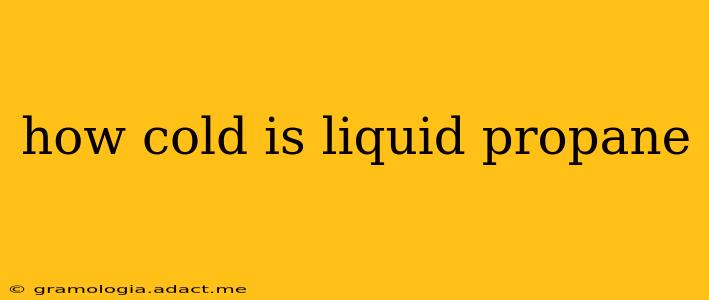Liquid propane, a common fuel source for heating, cooking, and vehicles, exists at a significantly lower temperature than its gaseous state. Understanding this temperature is crucial for safe handling and efficient use. But just how cold is liquid propane? Let's delve into the specifics and address some common questions.
What is the Boiling Point of Propane?
The temperature at which liquid propane boils and turns into a gas is its boiling point. This is a key factor determining its coldness. The boiling point of propane at standard atmospheric pressure (1 atmosphere) is -44°F (-42°C). This means that at this temperature, liquid propane will begin to vaporize. It's important to note that this temperature can fluctuate slightly depending on the pressure. Higher pressure will increase the boiling point, while lower pressure will decrease it.
How Cold Does Liquid Propane Get?
While -44°F (-42°C) is the boiling point, liquid propane itself can be slightly colder than this. The exact temperature will depend on factors like the storage conditions and the pressure within the container. However, it will generally remain very close to its boiling point. So, you can expect it to be exceptionally cold—significantly below freezing.
Is Liquid Propane Always -44°F?
No, liquid propane isn't always precisely -44°F. As mentioned earlier, pressure plays a significant role. Inside a pressurized tank, the propane remains a liquid at a higher temperature than -44°F. The pressure inside the tank keeps the propane in a liquid state even when the ambient temperature is warmer. Once released, the pressure drops, causing it to rapidly vaporize and cool to near -44°F.
What Happens When Liquid Propane Evaporates?
When liquid propane evaporates, it absorbs heat from its surroundings. This is why handling liquid propane requires extreme caution. Direct skin contact can cause severe frostbite, and accidental spills can rapidly cool the area and pose significant risks.
What are the Safety Precautions When Handling Liquid Propane?
- Always wear appropriate safety gear: This includes gloves, eye protection, and closed-toe shoes.
- Never handle liquid propane near open flames or sparks: The highly flammable nature of propane makes this a serious fire hazard.
- Use caution when filling propane tanks: Overfilling can create significant pressure and risk explosions.
- Ensure proper ventilation: Propane vapor is heavier than air and can accumulate in low-lying areas, leading to asphyxiation hazards.
Understanding the extreme cold of liquid propane is crucial for its safe and efficient use. Remembering its boiling point and the safety precautions listed above will help prevent accidents and ensure you utilize this valuable fuel source responsibly.
